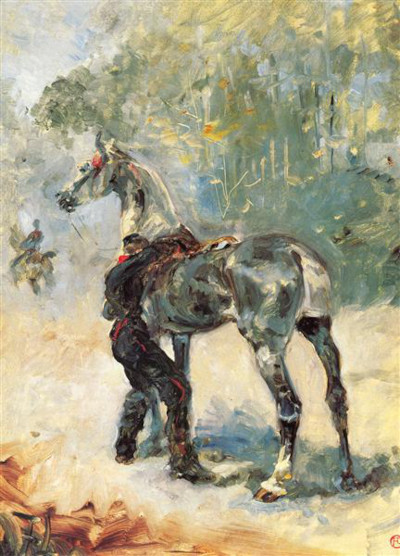Henri de Toulouse-Lautrec loved to paint horses in the early part of his career. He was frustrated at being unable to ride them himself due to his physical problems, but found solace by creating visual representations of these stunning creatures.
The Musee Toulouse-Lautrec, Albi, France hold this particular piece and many of the early works from his career can be found here. The artwork is relatively small and dated at 1879, meaning the artist would have been very much still a teenager at the time of this work. Even the most occassional art follower can still see considerable promise within Artilleryman Saddling his Horse, though, and it was clear that for all his problems, this was someone with genuine talent. He would fill much of his early oeuvre with horse portraits before later switching to less wholesome topics such as women from the night time economy, though the latter would become much more famous. The museum set up in his name continues to remind us of the full variety of genres in which he worked, and help to remind us of the stylistic journey that he went on across his short lifetime.
Toulouse-Lautrec features an artilleryman who is stood by his horse, carefully adjusting a saddle. The horse looks calm and contented, suggesting that the two have a strong bond and level of trust. The beautiful creature holds a strong posture, elegant and confident. It is also noticeably tall, giving a dominance over its rider within this composition. In the distance we can see another rider on horseback, with detail relatively blurred. There is also some form of landscape to the back and right of the work, though again the artist chooses not to distract us too much with precise detail. Much of the brushwork here is expressive in manner, and there is a clear stylistic difference to the later work that he produced.
The artist adored horses and featured them many times, with another memorable example being White Horse Gazelle. He was born into a rich family who owned and displayed horses themselves and he perhaps also felt unjudged by these creatures. Ultimately, he would move on later in his career to different content but these depictions offer an important view into his early development, both stylistically and also in the types of content that interested him. The museum dedicated to his career holds many from that period and is an excellent venue to learn more about his troubled but brilliant life and continues to teach new generations about this important painter and illustrator.




